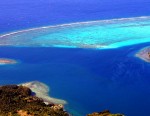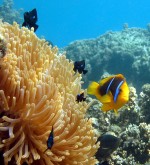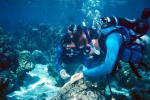New site offers scientists opportunity to study the structure, function, and dynamics of coral reef ecosystems
The newly established Moorea Coral Reef (MCR) LTER site will focus on the coral reefs that surround the south Pacific island of Moorea (17°30’S: 149°50’W). Moorea, located in the Society Islands of French Polynesia, also is home to the University of California’s Richard B. Gump South Pacific Research Station (http://moorea.berkeley.edu) which will serve as the logistical base for all MCR related field operations.
Scientists rank coral reef ecosystems near the top of all ecosystems with respect to annual total gross productivity and biodiversity despite the fact that these systems typically occur in warm, nutrient-poor waters. The large and diverse communities of corals found on coral reefs are fueled by efficient nutrient recycling processes. In turn, stony corals and their photosynthetic zooxanthellae (single-celled algae that live symbiotically within the coral tissue and provide photosynthetic energy to the coral host) serve as the foundation upon which tens of thousands of other species rely. Indeed, more than one third of all species of marine fishes occur in coral reef ecosystems despite constituting far less than one percent of the ocean bottoms.
Because of their complexity, scientists have an incomplete understanding of the multitude of abiotic forcing functions—external variables like temperature, currents, light, etc.—and biotic processes that collectively determine the structure, function, and dynamics of coral reef ecosystems. Global climate change and other perturbations are predicted to cause sweeping changes on coral reefs in the coming decades. A combination of monitoring and experimental studies carried out at a range of spatial scales will be necessary to elucidate the mechanistic basis of change in these systems.
Research Focus
Research at the MCR site will estimate long-term trends and address key gaps in our understanding of these complex ecosystems through long-term observations and experiments supplemented by shorter-term process studies. The goals of MCR LTER are to better understand coral reef processes that drive the functions of this ecosystem; the nature of coral reef animal and algal community structure and diversity; and the factors that determine the abundance and dynamics of related populations. These goals will be met through studies of trophic dynamics, such as the relationships among corals, fishes, and zooplankton; the physiological ecology of corals and their zooxanthellae symbionts; controls of reef productivity and ecological controls; and functional significance of biodiversity.
Two additional research components cut across these themes and will help to integrate and generalize the various research endeavors. These include an explicit focus on physical-biological coupling over multiple scales, and hydrodynamic, food-web, and ecosystem modeling. The understanding derived from the research will allow more accurate predictions of how coral reef ecosystems respond to environmental change, whether human-induced or from natural cycles. It will also serve as a knowledge base to inform government officials, resource managers, and others charged with the conservation and management of coral reefs.
Educational training and outreach both will be important components of the MCR site. Moorea will provide training in research and team research experiences for undergraduate and graduate students, as well as engage in post-doctoral training. One goal of the training will be to build linkages between US students and scientists and those in South Pacific and Pacific Rim nations. Outreach activities associated with MCR LTER will include K-12 programs in Southern California as well as community and school outreach in French Polynesia, and an internship program for Tahitian university students.
The four principal investigators for the award are affiliated with the University of California at Santa Barbara (Russell Schmitt and Sally Holbrook), and California State University at Northridge (Robert Carpenter and Peter Edmunds). In addition, scientists at the University of California at Santa Cruz, Scripps Institution of Oceanography, the University of California at Davis, and the University of Hawaii comprise the interdisciplinary team on the project. Research activities will include field monitoring and process studies, plus laboratory experimentation and modeling by the research team of ecologists, geneticists, physical and biological oceanographers, physiologists, modelers, biogeochemists, and molecular microbial biologists.
Location
Moorea is an ideal locality for an LTER site focused on coral reef ecosystems. All major coral reef types are present, are in good condition, and are highly accessible the year round. The UC Berkeley’s Gump Research Station provides an excellent base for field and lab operations, and the station is just a 30-minute ferry ride from the international airport on the island of Tahiti. There are daily non-stop flights to Tahiti from the west coast of the United States, and these flights last only a couple of hours longer than flights to Honolulu.
Moorea is a small volcanic island with an offshore barrier reef that forms shallow, narrow lagoons around the 60 km (40 mile) perimeter of the island. The rich research opportunities afforded by the reefs of Moorea are greatly facilitated by the existence of appropriate infrastructure and the ease with which field research can be conducted. The Gump Research Station has been operated by the University of California and administered by UC Berkeley since the early 1980s. Station facilities include two long-standing laboratory buildings with all the appropriate facilities, plus a third laboratory building containing research labs, a molecular lab, an IT center, and office space, which is nearing completion. In addition, the station has a flow-through sea water system, a dock, launch ramp, a fleet of small boats and vehicles, as well as a Scuba compressor and dive lockers. Station housing includes a dormitory and bungalows.
“We view the Moorea Coral Reef LTER to be the flagship research program of the Station,” says Neil Davies, Executive Director of the Gump Research Station,“ and we look forward to a long and productive partnership.”
“All of us associated with the Moorea Coral Reef LTER are thrilled to be part of the LTER network. It will afford a fantastic opportunity to interact with scientists working in a diverse array of ecosystems, and to conduct comparative studies to seek a more general understanding of the structure and function of natural systems,” says Co-PI Peter Edmunds.
For more information about the Moorea Coral Reef LTER please contact Andrew Brooks (brooks@lifesci.ucsb.edu); for more information about the Gump Research Station please contact Neil Davies (ndavies@moorea.berkeley.edu).

 Enlarge this image
Enlarge this image

